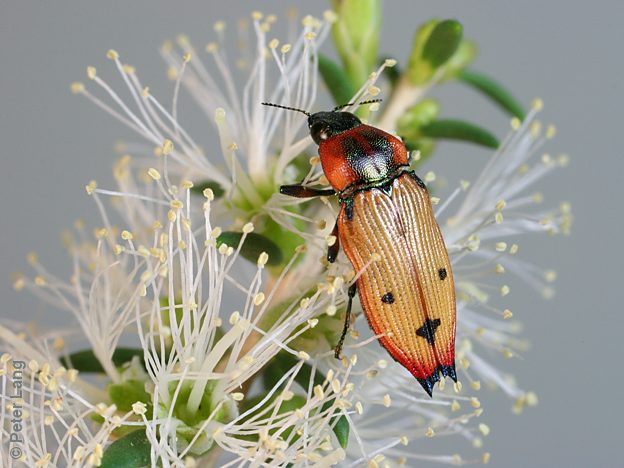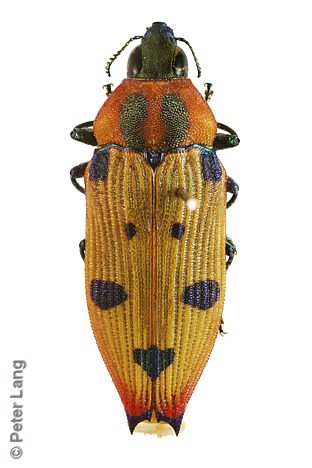

Actual
size¹:
size¹:
10.6 mm
×
3.7 mm
×
3.7 mm


| male | female | |||||
|---|---|---|---|---|---|---|
| L1 | 10.3 | 9 – 11.05 | n = 10 | 11.7 | 11 – 12.3 | n = 2 |
| L2 | 10.1 | 8.6 – 10.75 | n = 8 | 10.6 | n = 1 | |
| W | 3.6 | 3.1 – 4.05 | n = 10 | 4.1 | 3.9 – 4.25 | n = 2 |
| Legend | L1 | length from clypeus/frons to elytral apex (mean, range, sample size) |
| L2 | length from anterior of edge of eyes to elytral apex | |
| W | maximum width with elytra fully closed |
A semi-arid species mostly found in mallee flowers in summer. Uncommon in the Southern Lofty Region (SL) where known by an 1885 collection from Lyndoch at the south end of the Barossa Valley.
| Legend | P.J.Lang collection vouchered records | |
| other private collection or museum specimens, or sightings |
|
|
|
|
|
|
|
|
|
|
|
|
|
||||||||||||||||||||||||||||||||||||||||||||||||
|
|
|
|
|
|
|
|
|
|
|
|
|
||||||||||||||||||||||||||||||||||||||||||||||||
| Jul | Aug | Sep | Oct | Nov | Dec | Jan | Feb | Mar | Apr | May | Jun |
| Legend | live emerged adults, count > median value of 5 per quarter month | |
| live emerged adults, count <= median value of 5 | ||
| live non-emerged adults only, for that quarter month | ||
12 | number of active beetles for that quarter month |
| beetles | sites | SA regions¹ | family | position on host plant | ||||
| Eucalyptus leptophylla | 70 | 16 | EP, MU, SE | M | ||||
| Melaleuca lanceolata | 21 | 5 | EP | M | ||||
| Eucalyptus dumosa | 10 | 4 | EP, MU | M | ||||
| Eucalyptus socialis | 9 | 3 | EP, MU, SE | M | ||||
| Eucalyptus phenax ssp. phenax | 8 | 2 | EP, MU | M | ||||
| Eucalyptus sp. | 8 | 4 | NL, MU | M | ||||
| Eucalyptus oleosa | 5 | 1 | MU | M | ||||
| Bursaria spinosa ssp. spinosa | 3 | 1 | SE | P | ||||
| Melaleuca sp. | 2 | 1 | NU | M | ||||
| Eucalyptus calcareana | 2 | 2 | EP | M | ||||
| Eucalyptus cretata | 2 | 2 | EP | M | ||||
| Eucalyptus porosa | 2 | 1 | SE | M | ||||
| *Eucalyptus cladocalyx | 1 | 1 | NL | M | ||||
| Eucalyptus socialis ssp. socialis | 1 | 1 | MU | M | ||||
| Senna artemisioides ssp. filifolia | 1 | 1 | MU | F |
| Legend | beetles | count of beetles collected from, or sighted on, host plant taxon |
| sites | count of major sites (unique 10 km grid cells +/- some distinct approximate localities) | |
| * | indicates alien (non-native) plant occurrences, either wild or planted (the species may be alien in SA, or native in parts of its SA range) | |
| Plant names in green are hyperlinked to a matching host species page with plant photos. | ||
| Code | beetles | % | host plant taxa | |
| M | Myrtaceae | 140 | 97% | 10 |
| P | Pittosporaceae | 3 | 2% | 1 |
| F | Fabaceae | 1 | 1% | 1 |
| position | beetles | sites | |
| on flower(s) | 26 | 12 | |
| on flowering plant | 109 | 21 | |
| on foliage or non-flowering plant | 2 | 2 | |
| on dead foliage | 1 | 1 | |
| on plant (unspecified) | 7 | 2 |
| colour | beetles | sites | SA regions¹ | |
| blue | 3 | 2 | SE | |
| light pink | 1 | 1 | SE | |
| white | 1 | 1 | SE |
| ¹ Legend | regions | SA State Herbarium regions (map) EA: Eastern, EP: Eyre Peninsula, FR: Flinders Ranges, GT: Gairdner-Torrens, KI: Kangaroo Island, LE: Lake Eyre, MU: Murray, NL: Northern Lofty, NU: Nullarbor, NW: North-Western, SE: South-Eastern, SL: Southern Lofty, YP: Yorke Peninsula |
| size | The ellipse is the correct size when printed, indicative on a desktop screen, and likely to be wrong on a mobile device. |